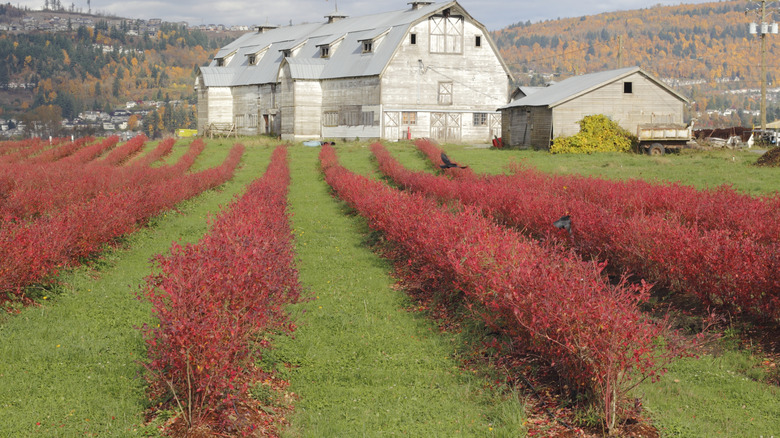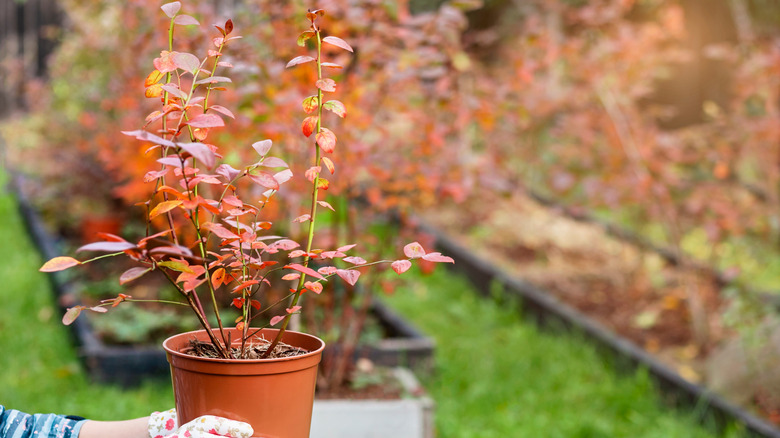The Winter Gardening Trick That Makes Propagating A Blueberry Bush A Breeze
Blueberries are amazing plants to have in your garden, producing huge yields once they are fully grown. However, just one blueberry plant may not be enough for you. Instead of spending exorbitant prices on a new bush, you can use your current plant to propagate several more. All you have to do is wait until winter and then take a few cuttings from your healthy and already-established plant. Blueberries are one of several fruit trees and shrubs you can grow from cuttings for delicious produce for years, making it easy to propagate more and more plants after you purchase and establish a few initially. In fact, this method of growing these bushes is easy and has a high chance of success. However, to ensure it has the highest chances of working without harming your established blueberry plant, you want to make sure you do it at the right time. Unlike softwood cuttings which are taken in spring or summer, hardwood cutting is another method of propagating blueberry bushes in the winter.
Hardwood cutting works well most of the time, though it can take a few months for the plant to establish itself. If you prefer to wait on starting them, you can also keep hardwood cuttings fresh until spring by trimming off a long shoot, then chopping off a six-inch portion from the bottom and storing it in the fridge with sawdust and peat moss. It's best to do this work when the bush is dormant during the winter. Of course, the length of winter is dependent on your location. For some areas, winter conditions can last from November to April, so it might be safe to cut the blueberries earlier or later. However, most people suggest taking the cuttings between January and February.
Take hardwood cuttings in winter for blueberries by spring
The key point with hardwood cutting that you'll want to wait until the plant has completely stopped its growth for the year, but before any new buds appear in the spring. When it's time, take your cuttings out of younger growth. While you can use cuttings from older wood, it's best to harvest pieces from branches less than a year or two old. To propagate blueberries, all you have to do is take cuttings that are about 6 inches long. They shouldn't be too thick, either; roughly a 1/4 inch in diameter – about the thickness of a pencil — is ideal. The more leaf nodes you find on the plant, the better, but you'll want at least three or four on every cutting.
Stick the cuttings into soil that stays moist, but doesn't hold water. They need to be roughly 2 inches into the soil, so about one third of each cutting is buried. Some of the leaf nodes should be above the dirt line, and a few below. While probably not necessary, you can also dip the part of the cutting you are putting underground into powdered rooting hormone. It's often used with plants that sometimes struggle to be propagated, but it can be useful if you have some lying around to speed up the process of your blueberries growing roots and to help ensure their success. Another option is to use cinnamon as a rooting hormone in your garden. This may be more practical anyway, as it's likely something you have lying around compared to rooting hormone. And if not, it's definitely less expensive to buy.
Helping hardwood blueberry cuttings produce a strong shrub
It can take roughly three to four months for the cuttings to actually develop strong roots, so don't worry about them growing slowly. However, because of how long it takes, it's also not a bad idea to start them right away in winter. If you live in a cold climate, you will probably need to let them grow indoors for a while to help prevent frost damage. However, if your winters are relatively warm, you may be able to grow them in pots outside, bringing them in during frosts.
Whether you are growing this plant inside or in your garden, it will need to stay warm and moist. Generally, temperatures between 70 and 75 degrees Fahrenheit are best for the young plants. Avoid waterlogging the soil, which can cause the cuttings to rot. If you're having a hard time balancing the moisture, you can cover your cutting and its pot in a plastic bag, though you'll need to leave it partially open for air flow. Once the plant establishes roots and the weather is ideal, you can bring it outside permanently. However, you don't have to move them out of containers. Blueberries produce shallow roots, which means they work well in pots, as long as you follow a few must-know tips for growing blueberries in containers.


